
Transportation in Boston includes roadway, subway, regional rail, air, and sea options for passenger and freight transit in Boston, Massachusetts. The Massachusetts Port Authority (Massport) operates the Port of Boston, which includes a container shipping facility in South Boston, and Logan International Airport, in East Boston. The Massachusetts Bay Transportation Authority (MBTA) operates bus, subway, short-distance rail, and water ferry passenger services throughout the city and region. Amtrak operates passenger rail service to and from major Northeastern cities, and a major bus terminal at South Station is served by varied intercity bus companies. The city is bisected by major highways I-90 and I-93, the intersection of which has undergone a major renovation, nicknamed the Big Dig.
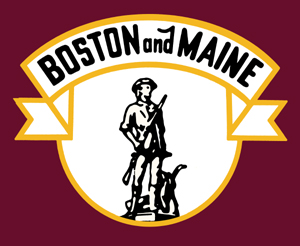
The Boston and Maine Railroad was a U.S. Class I railroad in northern New England. Originally chartered in 1835, it became part of what was the Pan Am Railways network in 1983.

North Station is a commuter rail and intercity rail terminal station in Boston, Massachusetts. It is served by four MBTA Commuter Rail lines – the Fitchburg Line, Haverhill Line, Lowell Line, and Newburyport/Rockport Line – and the Amtrak Downeaster intercity service. The concourse is located under the TD Garden arena, with the platforms extending north towards drawbridges over the Charles River. The eponymous subway station, served by the Green Line and Orange Line, is connected to the concourse with an underground passageway.

The MBTA Commuter Rail system serves as the commuter rail arm of the Massachusetts Bay Transportation Authority's (MBTA's) transportation coverage of Greater Boston in the United States. Trains run over 394 mi (634 km) of track to 134 stations. It is operated under contract by Keolis, which took over operations on July 1, 2014, from the Massachusetts Bay Commuter Railroad Company (MBCR).

The Downeaster is a 145-mile (233 km) passenger train service operated by Amtrak and managed by the Northern New England Passenger Rail Authority (NNEPRA), an agency of the state of Maine. Named for the Down East region of Maine, the train operates five daily round trips between North Station in Boston, Massachusetts, and Brunswick, Maine, with ten intermediate stops.

The Boston and Lowell Railroad was a railroad that operated in Massachusetts in the United States. It was one of the first railroads in North America and the first major one in the state. The line later operated as part of the Boston and Maine Railroad's Southern Division.

The North–South Rail Link (NSRL) was a proposed rail tunnel, or pair of tunnels, that would connect North Station and South Station in downtown Boston, Massachusetts, linking rail networks that serve the city's northern suburbs, New Hampshire, and Maine with the rest of the country. The project would build new underground stations near the existing stations, connect them with about 1.5 miles (2.4 km) of tunnels, and add other tunnels to link up with existing surface tracks.

Route 128 station is a passenger rail station located at the crossing of the Northeast Corridor and Interstate 95/US Route 1/Route 128 at the eastern tip of Dedham and Westwood, Massachusetts, United States. The station is shared by Amtrak and the Massachusetts Bay Transportation Authority (MBTA). It is served by most MBTA Commuter Rail Providence/Stoughton Line trains, as well as by all Amtrak Northeast Regional and Acela intercity trains. The station building, platforms, and parking garage are all fully accessible. It is the 23rd busiest Amtrak station in the country and the fifth busiest in New England.

The Lowell Line is a railroad line of the MBTA Commuter Rail system, running north from Boston to Lowell, Massachusetts. Originally built as the New Hampshire Main Line of the Boston & Lowell Railroad and later operated as part of the Boston & Maine Railroad's Southern Division, the line was one of the first railroads in North America and the first major one in Massachusetts.

Providence station is a railroad station in Providence, Rhode Island, served by Amtrak and MBTA Commuter Rail. The station has four tracks and two island platforms for passenger service, with a fifth track passing through for Providence and Worcester Railroad freight trains. It is now the 11th busiest Amtrak station in the country, and the second-busiest on the MBTA Commuter Rail system outside of Boston.
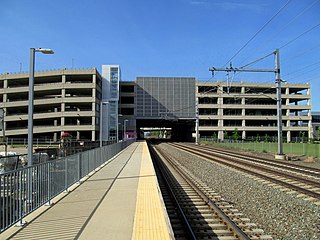
T. F. Green Airport station is a train station and intermodal facility in Warwick, Rhode Island, on the Northeast Corridor, adjacent to T. F. Green Airport. It extends the MBTA Commuter Rail Providence/Stoughton Line from Boston, which previously only went as far as the Providence train station. The station was completed in October 2010 and MBTA service began on December 6, 2010. On November 14, 2011, service expanded to 10 weekday trains in each direction. Trips to and from Boston's South Station take 75 to 90 minutes.

Durham–University of New Hampshire station, also known as Durham–UNH station or simply Durham station, is a passenger rail station in Durham, New Hampshire, served by Amtrak's Downeaster line. The historic depot, which now houses the UNH Dairy Bar, is situated just west of downtown Durham on the campus of the University of New Hampshire (UNH). The station is owned by the university, but an adjacent parking area is managed by the town of Durham. On average, about 161 rail passengers board or detrain daily at Durham, making it the third-busiest Amtrak stop in New Hampshire.
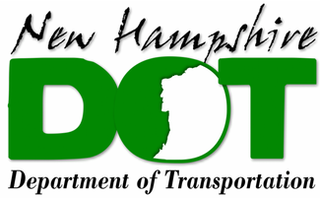
The New Hampshire Department of Transportation (NHDOT) is a government agency of the U.S. state of New Hampshire. The Commissioner of NHDOT is Victoria Sheehan. The main office of the NHDOT is located in the J. O. Morton Building in Concord.
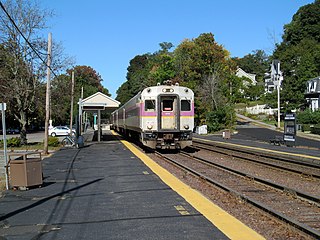
The Haverhill Line is a branch of the MBTA Commuter Rail system, running north from downtown Boston, Massachusetts through the cities and towns of Malden, Melrose, Wakefield, Reading, Wilmington, Andover, North Andover, Lawrence, and Haverhill.

The Providence/Stoughton Line is an MBTA Commuter Rail service in Massachusetts and Rhode Island, primarily serving the southwestern suburbs of Boston. Most service runs entirely on the Northeast Corridor between South Station in Boston and Providence station or Wickford Junction station in Rhode Island, while the Stoughton Branch splits at Canton Junction and terminates at Stoughton. It is the longest MBTA Commuter Rail line, and the only one that operates outside Massachusetts. The line is the busiest on the MBTA Commuter Rail system, with 17,648 daily boardings in an October 2022 count.

Haverhill station is an intercity and regional rail station located in downtown Haverhill, Massachusetts, United States. It is served by Amtrak's Downeaster service and the MBTA Commuter Rail Haverhill/Reading Line; it is the northern terminus of MBTA service on the line. Haverhill is one of two major hubs for MVRTA local bus service; the Washington Square Transit Center is located 1⁄5 mile (0.32 km) east of the rail station.

Dover Transportation Center is an Amtrak train station in Dover, New Hampshire, United States. The station is served by five daily Downeaster round trips. An average of 150 passengers board or alight at Dover daily, making it the second-busiest stop in New Hampshire.
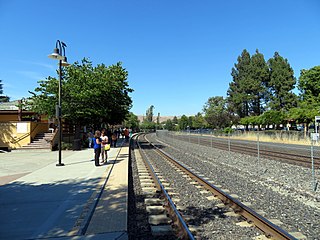
Fremont station is a train station located in the Centerville area of Fremont, California, United States. The station is served by Amtrak Capitol Corridor commuter rail/intercity rail service and the Altamont Corridor Express (ACE) commuter rail service. The station has two platforms serving the two tracks of the Niles Subdivision. Most trains use the longer west platform.

Union Station is a railway station located at Washington Square in downtown Worcester, Massachusetts. It is the western terminus of the MBTA Commuter Rail Framingham/Worcester Line and a stop for the Amtrak Lake Shore Limited service. A bus terminal adjacent to the station is the hub for Worcester Regional Transit Authority (WRTA) local bus service; it is also used by PVTA, MART, Peter Pan, and Greyhound intercity buses.

East-West Rail is a proposed intercity passenger rail project that would provide new service between Boston and western Massachusetts, with stops including Worcester, Palmer, Springfield, Pittsfield, and Amtrak's Albany–Rensselaer station in New York. The 171-mile (275 km) route between Boston and Albany would use the former mainline of the Boston and Albany Railroad, which is now owned by the Massachusetts Bay Transit Authority and CSX Transportation.


















